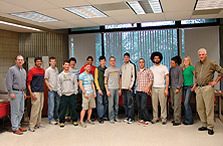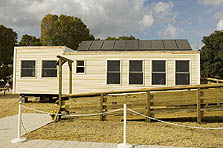

UMass Dartmouth's team drew inspiration from its work with Habitat for Humanity.

UMass Dartmouth's house was designed to fit into the northeast Washington, D.C., neighborhood where it will ultimately reside.
Solar Decathlon 2005
University of Massachusetts Dartmouth
Big-Hearted Effort
The University of Massachusetts Dartmouth (UMass) may be the smallest of the five Massachusetts state universities, but its Solar Decathlon entry proves that its students have hearts as big as any school could boast. The overarching objective and guiding force for the project was to build it as a Habitat for Humanity house. When the Decathlon is over, the house will be moved from the National Mall to the northeast area of Washington, D.C., where it will be permanently installed as a Habitat-provided house.
Sixteen members of the UMass Dartmouth team jumpstarted the process more than a year ago with a spring-break trip that defied the usual fun-in-the-sun stereotype. On that trip to Loudon County, Tennessee, they helped an Oak Ridge National Laboratory team build its fourth "energy smart" home as a donation to Habitat. Next year, the UMass Dartmouth team and the local Habitat chapter it spawned will join with another chapter to build a Habitat house in Plymouth, Massachusetts.
The UMass Dartmouth home uses a computerized control system to draw heat and cooling from phase-change materials. The materials, which are made from blocks of cloth, are in containers under the front windows. The home was deliberately designed, however, to use off-the-shelf components as much as possible and deemphasize cutting-edge technology. "We tried to make the home as comfortable, normal looking, and acceptable for the D.C. location as possible," says Tom Celona, student project leader.
The home uses a combination of forced-air heat exchange, passing intake air by the phase-change material, and radiant-floor piping heated by one of two rooftop evacuated-tube solar thermal collectors. The other collector provides domestic hot water. Lighting is a combination of compact fluorescents and passive lighting, including light "tubes" to bring light down from the roof. All appliances were donated by Whirlpool, an ongoing sponsor of Habitat for Humanity. "They are Energy Star, but we worked with Whirlpool to pick as 'ordinary' ones as we could," says electrical engineering student Kenny Ventura.
The team also enjoyed extensive support from the local South Coast Massachusetts community. New Genesis Construction led the actual construction. Teachers at a local vocational technology school provided electrical, plumbing, heating, ventilation, and air-conditioning advice.
Team Contact
Gerald Lemay, PhD, PE
ECE DEPT UMASSD
285 Old Westport Road
North Dartmouth, MA 02747-2300
508-999-8535
